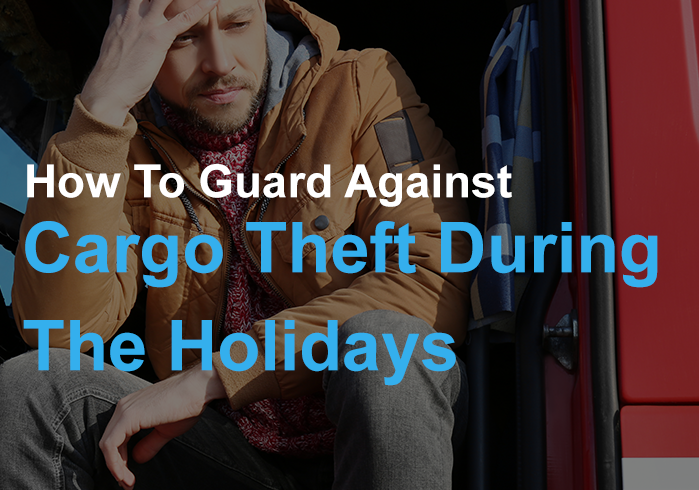
The holidays are with us and there is a new report out warning shippers and drivers to guard against cargo theft. The July Fourth risks of losing cargo are well known in the industry. Statistical estimates indicate that theft tends to increase around public holidays, especially ones that involve high levels of consumer shopping.
Although cargo theft is an ongoing problem for the trucking industry throughout the season, it makes sense that criminals would escalate their efforts when high value products are being imported and exported. CargoNet released a report on the 29th of June indicating that a total of $5.9 million worth of cargo was stolen in the last half a decade. This article examines the key risks and possible interventions based on recommendations by crime analysts. As a starting point, it is important to examine the anatomy of a crime heist.
What does a cargo heist look like?
Typically, a cargo heist is defined in terms of the average losses made, the types of goods that have been targeted, and the areas of specific vulnerability. Estimates indicate an average heist coming in at about $130,000 worth of goods. The most popular products include building materials, household goods, and beverage items.
Scott Cornell (a business lead, and Travelers’ theft specialist) suggests that extended weekends are an ideal timeframe for cargo thefts. For example, thieves have a longer period to escape since most of the security staff is off of work. That extra day before the search for missing cargo can make the difference between recovery and permanent loss.
Thieves tend to target highly populated areas such as Florida, California, and Texas. These are high-volume consumption areas and that significantly increases the size or value of the cargo. A single heist in these areas could potentially be worth more than several heists in rural low-density areas. Understanding these patterns is part of an overall risk assessment program for businesses.
Key risk assessments for cargo thefts
A risk assessment typically focuses on the most vulnerable areas. Businesses need to be wary of organized crime and confidence tricksters that rely on persuading people to let their guard down.
One of the high-risk areas in any establishment is the parking lot. Thefts can also occur on truck stops and in unsecured yards. Drivers should therefore be more selective about the places that they leave their vehicles when carrying goods. It is also important to be on the lookout for distractions that take the driver away from the vehicle so that the thieves can carry out the crime.
Two types of cargo thefts have emerged over the years. The first involves stealing the entire truck, to be unloaded later and the goods redistributed within the criminal network. This type of technique suits organized crime rings because it involves several additional processes that require technical expertise and contacts.
The second modality involves breaking into the back of the trailer. This usually happens when the driver is asleep in the truck or has otherwise left the truck untended. The thieves will then clear off with any or all the cargo.
Both methods involve complicated surveillance and reconnaissance work. The criminals will be familiar with the lay out of the distribution centers and the various procedures that are involved. In some cases, they may even have an insider working for them to track the exact location of the targeted cargo.
Because of the intricate planning involved, these criminals tend to operate in small groups. They do not need large crowds which can attract unwanted attention. The operation is so well coordinated that a driver often does not even realize that they have been robbed.
The rest patterns and habits of the driver might have a role to play. For example, some leave the tractor running as they are sleeping to stay warm in a cold area. The noise produced does not allow for clear awareness of the environment. Because drivers are always at least 50 feet away from the rear doors, they cannot easily run to apprehend the thieves even if they hear any strange noises. Some have reported not hearing anything even when the trailer is being moved.
Over time, criminals have become more and more efficient. They can infiltrate trucking companies and gather valuable information. These confidence tricksters will pretend to be helpful when they are actually finding ways of beating the system. Businesses need to develop a framework for preventing and responding to cargo theft.
Key tips when ferrying cargo
You can protect your business from cargo theft by considering the implementation of five key measures.
1st TIP: Use regular police checks
You should develop partnerships with the local law enforcement agencies so that they can undertake routine checks on the premises. This is particularly important during the holiday downtime when your regular security staff may be off of work. The police presence by itself can be off-putting for criminals.
2nd TIP: Keep accurate records
Keep accurate data of all your equipment. This information can be useful in tracing the cargo. Some of the key records to keep include the VIN, license plate, and detailed vehicle description. Even when you have a rogue driver intending to steal cargo, this information will help.
3rd TIP: Secure vessels
Ensure that all your vessels are protected throughout the process, including: loading, unloading, and transit. Invest in high-security locking devices for all your trucks to make it difficult for thieves to get in and out. Examples of these include steering column locks, air cuffs, and sensors.
4th TIP: Ensure all cargo is always attended
Drivers should complement these efforts by reducing the need to make long stopovers and extended absences away from the vehicle. Some of these measures include ensuring that the tank is full before travelling, showering, and eating beforehand. All drivers should be getting sufficient sleep before travelling.
5th TIP: Attend to all alarms
Assume that there is no false alarm. There should be clear protocols for responding to distress calls in a timely and appropriate manner. Some of these criminals have perfected the science of tricking the alarm systems through deliberate tripping so that drivers start to believe that a real alarm is a false one. Do not allow anyone to create the impression that the alarm system is broken and therefore does not require a response when triggered.
Wrapping up
Finally, ensure that you have all your documentation ready. All suspicious activity should be reported regardless of how near or how far it is from the facility. Due diligence and early preparation can help you reduce any losses from stolen cargo.


